Today is the feast of St. John, and we spent it in the center of one of the oddest parts of the natural world, Kirstenbosch, the great botanical garden of the Cape. The whole world is divided into six “floristic provinces,” where general distinctions in flora can be observed, and for the most part they are aligned with the continents: the holarctic (North America, Europe, and northern Asia); the paleotropical (most of Africa, Arabia, and India); the neotropical (South America); the Australian; the Antarctic; and then the Cape Region of South Africa, far and away the smallest and most unusual of all the floristic provinces of the world. The Cape is a small nub of temperate zone utterly isolated from other temperate zones; it is also an area which has never been denuded by glaciers, and whose flora has been constant and isolated for millions of years. Consequently three percent of the world’s total plant species occur in one corner of this one country, and most of those species occur nowhere else. Dominant here are a group of plants known as the Proteaceae, a disparate group of plants whose common ancestry was first identified by Linnaeus despite the diversity of the family: he named these proteaceae, it is said, after the Greek god Proteus, the Old Man of the Sea, who was capable of changing his shape at will.
They certainly are odd plants: many with wildly large flowers, blooming here in winter, and pollinated frequently not by insects but by birds and mammals (often it is the feet of the birds and mammals which pollinate them). Some have flower structures which look quite similar to pine cones. Many of them are also exceptionally beautiful: one does not need to know that they are unusual to admire them.
The highways in Cape Town all had directions for “Kirstenbosch” – a single word, with no need to note that it was a botanical garden. The area around the gardens looked to me like Hawaii – vast, multimillion-dollar homes whose pools and views of the Atlantic and perfect lawns and guest cottages and BMWs were obscured by impossibly luxuriant tropical foliage and siegeproof fences. We arrived to find an empty parking lot, parked and went in. Admission cost about three dollars. As soon as we had paid our admission, the skies opened and sheets of water fell out of the sky – as hard and tropical a rain as I have ever seen. We diverted ourselves by visiting the shop, where everything seemed great but nothing seemed quite perfect, as happens to me in gift shops. After about twenty minutes the rain passed and we had all of Kirstenbosch to ourselves – what few people were there had been washed away by the rain.
The gardens are laid out on the slopes of Table Mountain, whose ridge rises most impressively above the treeline, closing off the horizons. Today the mountain was clothed in clouds. It is winter of course, and many of the plants are absent – I saw a sign for Vernonia natalis, the Natal ironweed, a plant I would love to see, to compare it with our New-York ironweed, Vernonia noveboracensis, but like other vernonias it had died to the ground for the winter; and I believe the garden has impressive displays of annuals, which are not to be seen now. Whether it was because of the season, or because of the nature of the collection I do not know, but the garden was extraordinary more because of its diverse collection of superb plants than because they are ingeniously arranged or disposed. The largest and showiest of all the proteas, the King Protea, Protea cynaroides, was in bloom, and signs directed us to it, but there were only a few specimens of this plant in the garden, despite it being the national flower of South Africa and an incredible showy, beautiful plant. I had expected this protea – one of the flagship plants of the garden, found on mugs, plates, keychains, notepads, and suchlike in the gift shop – would be represented by more than a dozen small plants, especially since the sign for the plant noted that it was easy to grow, required no care in the Cape, and bloomed from seed within four years. But this was not the garden to go to for massing of plants: rather there was incredible variety, with dozens of different proteas. Many, though not all, had started to bloom, and they were exquisite.
Also truly superb were the aloes, many of which were very large and all of which were blooming, with fantastic, hummingbird-red flowers. I did not see any hummingbirds on them, however: instead I saw sunbirds, small passeriform birds, which looked like the progenitors of hummingbirds. They did not have the agility or hovering power of hummingbirds, and so they simply landed on the inflorescences and, holding on with their talons, stuck their long curved beaks into the tubular flowers. They were far less impressive than hummingbirds, but seemed to do the job well enough in their absence. There were also all kinds of curiosities, particularly to someone from a different floral province: tree-sized asteraceae and gardenias that have to pass through the digestive systems of elephants in order to germinate.
But to me the most impressive plants I saw there were the succulents, mostly euphorbias, which had evolved to look almost exactly like cactuses, a glorious example of convergent evolution. In particular the Transvaal Candelabra Tree, Euphorbia cooperi, was one of the most impressive plants I have ever seen: from a stout central trunk rose upward-curving branches like a hundred-armed menorah; the branches noded into green pyramidal segments, like some dragon of fantasy. These euphorbias lived happily amongst other plants, and together with the red blossoms of the aloes they formed the best desert garden I have ever seen. This is a relatively well-watered region, and apparently these succulents tolerate the damp: they just grow more thickly on the ground.
I enjoyed, as I always do, walking through the garden, and trying to appreciate the individual lives I saw here in bloom; and everything seemed organized by Providence for our pleasure. As we came to the end of our tour we came to a tea-house, where we took a late lunch; as soon as we sat down it began pouring sheets of rain again, which stopped as soon as we had paid the bill. We had seen hundreds more plants utterly new to us: like coming to know, in a single day, hundreds more Thoughts of God.
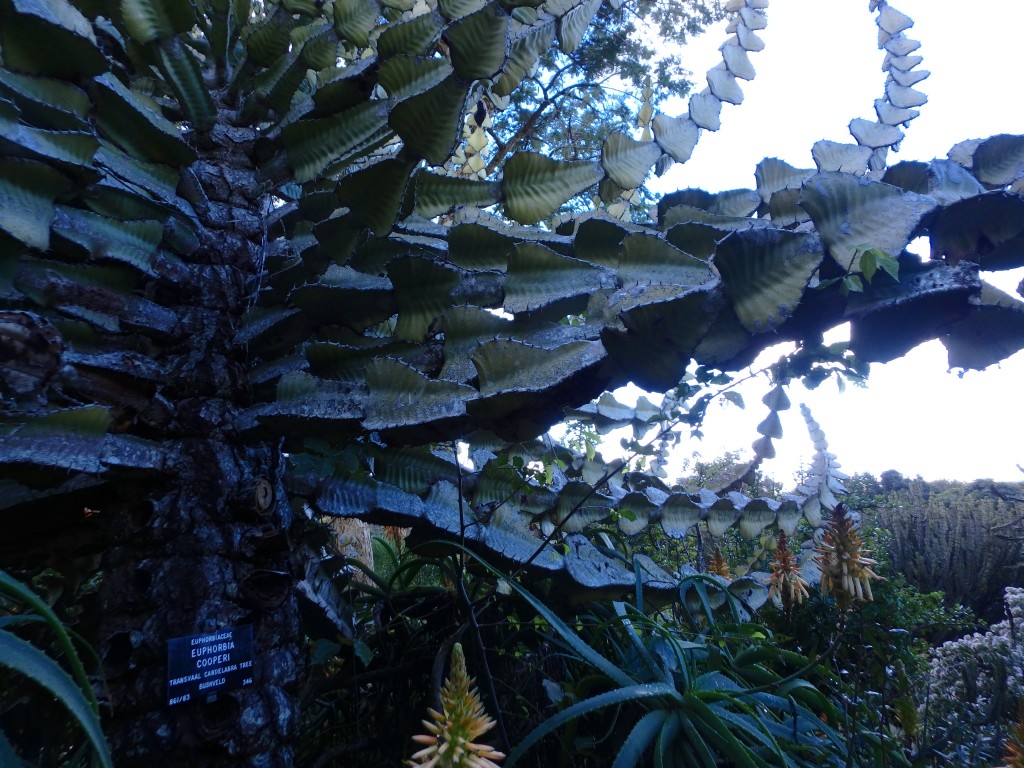
Euphorbia cooperi, the Transvaal Candelabra Tree. I should have spent more time trying to photograph this plant well.
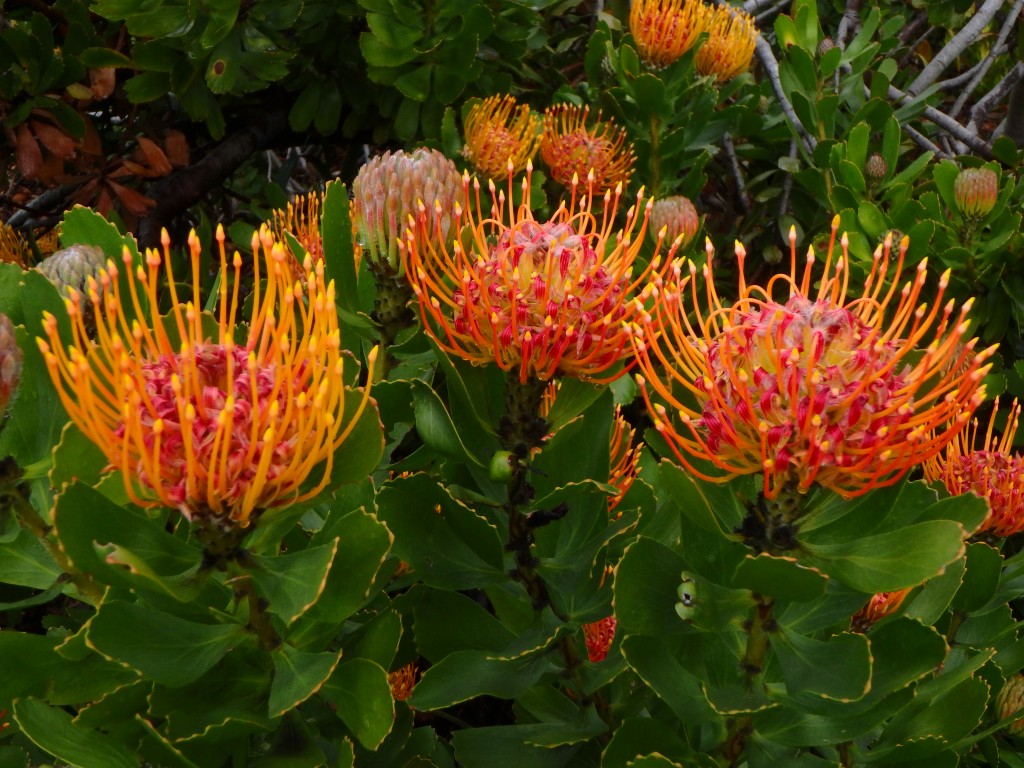
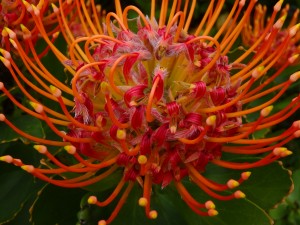
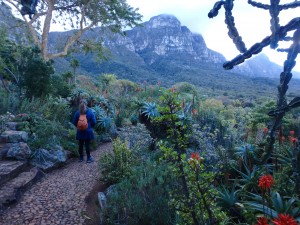
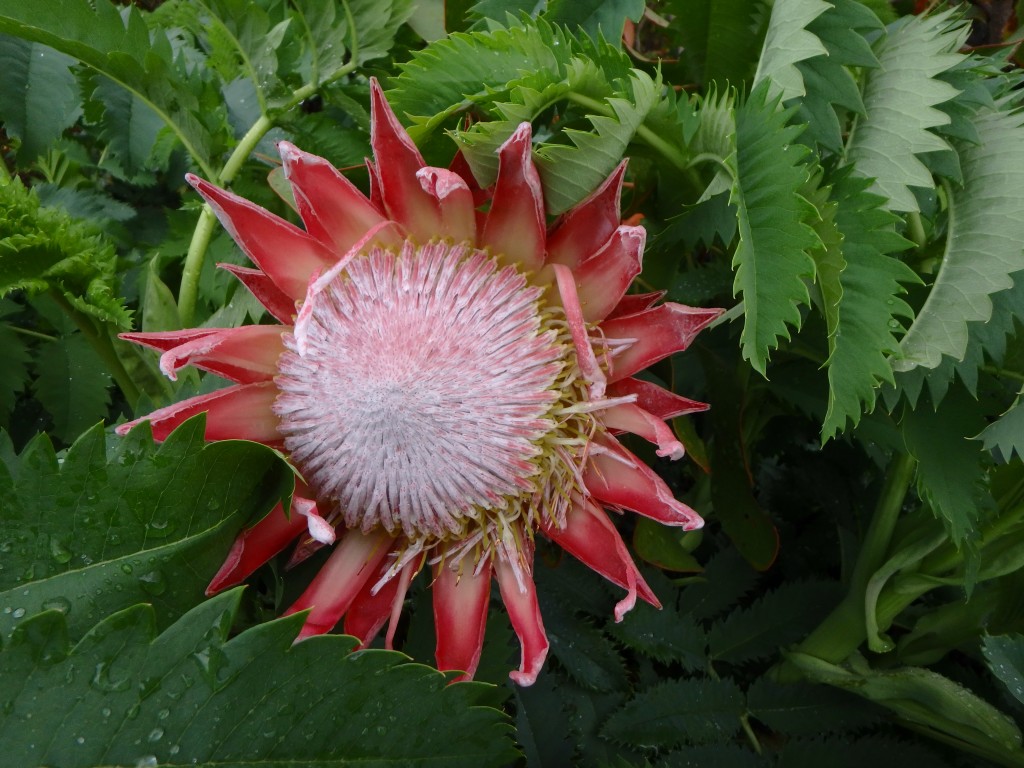
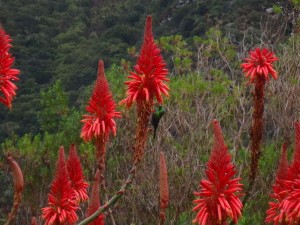
2 Comments